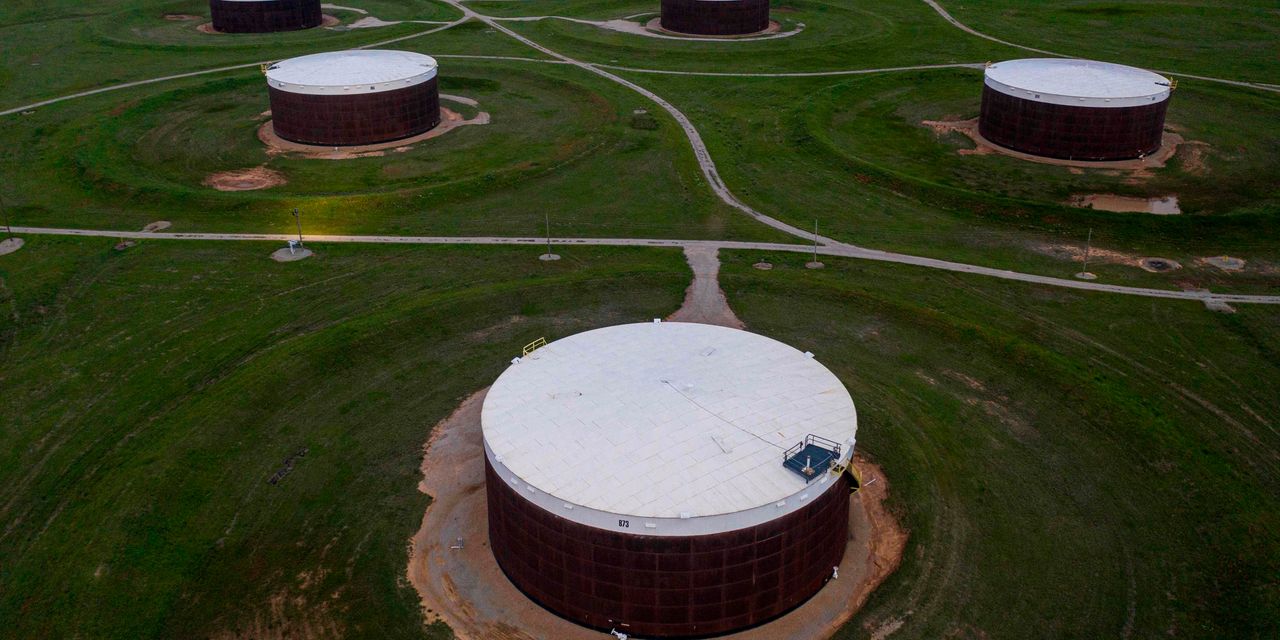Oil futures climbed on Thursday, with U.S. prices settling back above $70 a barrel for the first time in almost a week, ahead of Sunday’s OPEC+ decision on production levels, even as U.S. government data reveal an unexpected weekly rise in domestic crude supplies.
Oil is coming off a large May tumble, tied to worries about the global economic outlook.
Price action
-
West Texas Intermediate crude for July delivery
CL00,
+0.18% CL.1,
+0.18% CLN23,
+0.18%
rose $2.01, or 3%, to settle at $70.10 a barrel on the New York Mercantile Exchange, posting the first front-month finish since last Friday. The move comes just a day after prices settled at their lowest since March 20. -
August Brent crude
BRN00,
+0.35% BRNQ23,
+0.35% ,
the global benchmark, added $1.68, or 2.3%, at $74.28 a barrel on ICE Futures Europe. -
Back on Nymex, July gasoline
RBN23,
+0.17%
shed 0.3% to $2.44 a gallon, while July heating oil
HON23,
+0.23%
rose 2.8% at $2.31 a gallon. -
July natural gas
NGN23,
+0.23%
dropped 4.8% to settle at $2.16 per million British thermal units.
Supply data
Overall, the U.S. petroleum supply data were “bearish,” said Tariq Zahir, managing member at Tyche Capital Advisors.
However, “prices — not to our surprise — are strong” as several factors will come into play in the days and weeks ahead, including Sunday’s OPEC+ meeting, with the possibility of a further cut in supplies, he told MarketWatch.
The Energy Information Administration on Thursday reported that U.S. commercial crude inventories rose by 4.5 million barrels for the week ended May 26.
That compared to an average decline of 3.4 million barrels forecast by analysts polled by S&P Global Commodity Insights. The American Petroleum Institute late Wednesday reported a 5.2 million barrel increase in U.S. crude inventories last week, according to a source citing the data.
The build in crude stocks “primarily reflects a rebound in net imports following a week of both strong exports and extremely week imports, amid restrained domestic refinery runs,” said Troy Vincent, senior market analyst at DTN.
The EIA report, which was released a day later than usual due to Monday’s Memorial Day holiday, also showed a weekly inventory fall of 200,000 barrels for gasoline, while distillate supplies climbed by 1 million barrels.
Analysts had forecast weekly declines of 500,000 barrels for gasoline and 280,000 for distillates.
Crude stocks at the Cushing, Okla., Nymex delivery hub climbed by 1.7 million barrels for the week, the EIA said, while oil stocks in the Strategic Petroleum Reserve fell by 2.5 million barrels.
OPEC+ decision on tap
WTI fell more than 11% in May, its biggest monthly percentage drop since November 2021. Brent dropped 8.7% in May, its largest one-month drop since November 2022.
“Manufacturing, industrial, and freight data globally continues to reflect pronounced weakness in energy and oil intensive business activity,” said Vincent. “Combine this with strong non-OPEC supply growth, and the EIA acknowledging that they were underestimating U.S. crude production by the tune of nearly 500,000 [barrels per day] in their latest monthly data released [Wednesday] for March, and you can see why the pressure is growing for OPEC+ — and particularly Russia — to actually deliver on their announced production cuts if they hope to keep prices from sliding lower.”
A June 4 meeting of OPEC+—the Organization of the Petroleum Exporting Countries and its allies, including Russia—is in focus.
Read: Why OPEC+ will have a hard time surprising the oil market this weekend
The meeting “could be a market mover if we see another cut” in production, said Tyche Capital Advisors’ Zahir. In early April, OPEC+ announced an unexpected, additional reduction in output quotas that went into effect in May.
OPEC wants to see higher markets as market share is being impacted by Russia selling oil to China, Zahir said.
Saudi Arabia’s energy minister earlier this month warned that short sellers should “watch out,” remarks that were viewed by analysts as a warning that a further round of production cuts could be in the offing.
But Russia’s deputy prime minister subsequently said he saw no need for additional measures.
“Oil market participants expect the nine major OPEC+ producers, which announced voluntary production cuts in April, to keep production unchanged. And while they will most certainly ramp up the ‘ouching’ rhetoric, one possible outcome is that OPEC could broaden the cuts to smaller producers,” said Stephen Innes, managing director of SPI Asset Management, in a note. “However, in the absence of Russian compliance, whether this will stem the pessimistic tide is debatable.”
In the U.S., the debt-ceiling bill passed the House of Representatives in a clear majority on Wednesday and now heads to the Senate, where the bill is expected to pass there too, said Victoria Dircksen, commodity analyst at Schneider Electric, in a daily report.
“If the bill is passed, it will prevent the U.S. federal government from avoiding defaulting on its debt, and it will also enhance the prospects of oil demand growth in the world’s largest consumer of oil,” she said.
Meanwhile, natural-gas futures ended with a loss of nearly 5% after the U.S. Energy Information Administration reported on Thursday that U.S. natural-gas supplies in storage rose by 110 billion cubic feet for the week ended May 26.
Analysts called for a storage increase of 107 billion cubic feet on average, according to a survey conducted by S&P Global Commodity Insights, which said that for the same week a year ago, supplies climbed by a much smaller 82 billion cubic feet.
Read the full article here












